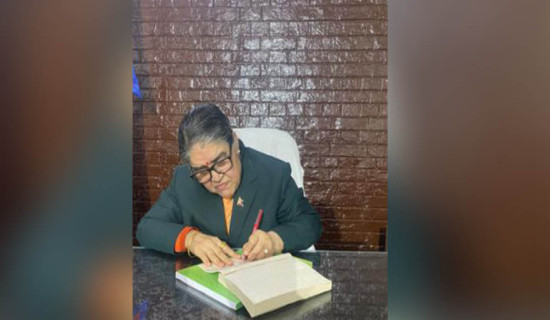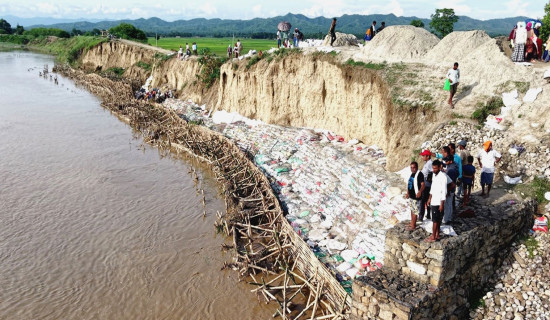- Wednesday, 16 July 2025
Where Luchubhulu Ajima Lives
Aashish Mishra
If the phrase ‘hidden in plain sight’ applies to anything, it is to the residence of Shree Luchubhulu Ajima at Mahabouddha. Despite being four-storey tall and having bright red walls, the building, which is the god-house (Dya Chhén) for the locals, is easily missed.
Dominated by the large new building of the Bir Hospital and the larger and newer private houses that stand around it, this grandly meek, or meekly grand, structure fails to command as great an attention as its modern neighbours. Its copper roofs, golden latticed window, exquisite tympanums, elaborately carved struts and the majestic façade, which, according to architect Carl Pruscha’s book ‘Kathmandu Valley: The Preservation of Physical Environment and Cultural Heritage’, was built in the 17th century, fail to stand out in the way they once undoubtedly did.
Located on one of the busiest streets of Kathmandu Valley, many look at the holy habitation every day but the scribe fears that they do not see it. Much like so many other monuments of Kathmandu Valley, people, other than those of the community associated with it, neither understand what the building is nor are curious enough to find out. This scribe admits that he himself wasn’t until a recent heritage walk with a friend.
Luchubhulu Ajima is a manifestation of Goddess Bhadrakali and this building at Mahabouddha is her home, with her temple being 600 metres away at Kel Tole.
Now, before moving forward, it is important to understand the distinction between a deity’s home and temple. Many of us believe that gods live at the temple where they are consecrated. That is why we place so much importance on them. They do not lose their value even if the idol or relic they hold is stolen or destroyed.
But in the case of specific divinities, the temple, for lack of a better comparison, is more of a workplace. It’s an office that holds a representation of the god’s energy with the actual god residing at a separate dedicated home. Like we do not live at our office, our gods do not live at theirs. It is only a site to visit on specific occasions.
For Luchubhulu Ajima, one such occasion is Pahan Charhey or Ghode Jatra. On this day, the Ajima’s statue is brought out of her home and taken to her three-roofed temple near the Janabahal courtyard that features erotic carvings from the Kama Sutra on its struts.
Legend has it that a vain tantric who lived centuries ago once felt he had become so powerful that he could subdue the gods. So, he decided to use his powers to capture Goddess Bhadrakali.
Every night for seven nights, he went to Bhadrakali’s shrine and performed great oblations and sacrifices. He used every trick in his arsenal and finally, on the seventh night, he was able to trap the celestial mother in an urn.
But the presence of the goddess made the vessel so heavy that the tantric could no longer carry it alone. So, he called three of his disciples to help.
Together, the four lifted the pitcher and began taking it home but again, since it contained an imprisoned numen, it attracted all sorts of energies and spirits that the tantric and his pupils needed to put down with spells. But to cast those, they needed free hands which meant putting the urn down.
So, every time a spectre appeared, they would put down the container, clear their path and pick it back up. But every time they did that, the urn got heavier. Finally, it got too heavy when the group reached today’s Kel Tole. They had put it down at the side of the road to fight some ghosts but now, could not lift it again.
This made the tantric angry and he kicked the vase in rage. This upturned it and set Bhadrakali free.
Immediately after her release, the goddess killed the narcissistic sorcerer and looked to kill his three apprentices, but they begged for mercy. They explained that they were only acting on the orders of their master and pleaded for their lives.
Bhadrakali agreed to spare them but only on the condition that they never misuse their tantric powers and build a temple to her at the place where they presently stood. They agreed and the Bhadrakali Temple of Kel Tole came into existence.
Locals still share versions of this story among themselves and culture blogger Sandeep Maharjan, better known by his nom de Web Frannkey Franz, has also described this myth in his 2021 article published on the website Yentra.
Such rich mythology associated with the house at Mahabouddha that this reporter has seen people mistake for a Phalcha or a public shelter.

















